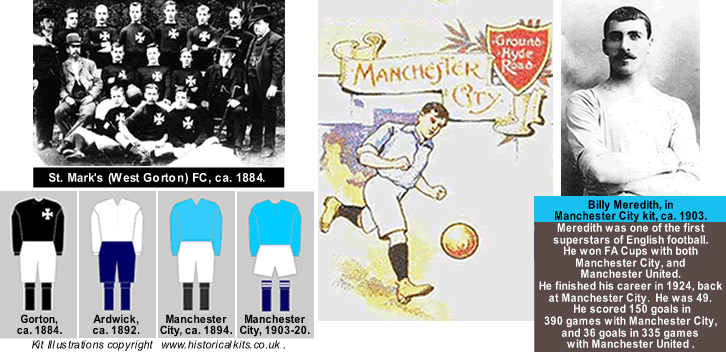
Historical Football Kits, Manchester City page.
In 1879, Anna Connell, daughter of St. Mark’s Church rector Arthur Connell, formed a social association for young men, in Manchester. After the success of their cricket team, a football club was formed the following year, 1880. It was named St. Mark’s (West Gorton) FC. In 1887, the club changed it’s name to Ardwick AFC, and they moved into their new grounds, Hyde Road. The grounds’ first seating area was built in 1888, for 1,000 spectators. But the swift rise in popularity of the club would result in numerous upgrades in the facility, and by 1904, Hyde Road could accomodate 40,000.
Ardwick FC joined the Football Alliance in 1891. They joined the Football League in 1892, in the newly created Second Division. After financial troubles, the club was re-formed, in 1894, as Manchester City FC. They adopted Cambridge Blue (sky blue), and white as their colors. Five years later, in 1899, Manchester City won the Second Division, and were promoted to the First Division. Though they finished in 7th place there in 1900, they were relegated back to the second tier in 1902. They bounced right back to the top flight in 1903, and almost won the national Title in 1904, finishing in 2nd place. They did, however, win the 1904 FA Cup, beating Bolton Wanderers 1-0, in front of 61,000 at the old Crystal Palace. This was the first time the Final featured two clubs from Lancashire. City’s best player, captain Billy Meredith, scored the goal in the 23rd minute. 
The club stayed competitive the following two seasons, with 3rd and 5th place finishes. But a scandal erupted in 1906, when the League penalized 17 Manchester City players and 3 club officials for financial irregularities. The club had been found to be paying players a higher wage than was allowed. All the players were suspended for 18 months, and banned from the club.
The scandal was a huge blow to the club, made worse by the fact that several of the players (including Meredith) ended up on cross-town rivals Manchester United. City were relegated in 1910. But they won the Second Division in 1911, and returned to the top tier. In 1915, at the onset of the Great War (now known as World War I), Manchester City finished in 5th place. After the war, Manchester finished 7th in 1920, and in 2nd place in 1921. There was a fire at their Hyde Road grounds in November, 1920, which destroyed most of the main stand. The club began planning for a new stadium. In 1923, Manchester City moved into their new ground, Maine Road, in the Moss Side district of urban Manchester. Maine Road was the second largest stadium in the country, with a capacity of 84,000. Center-back Sam Cowan debuted for Manchester City in 1924. He would make 406 appearances for the club (from 1924-35) {See Sam Cowan bio, here}. But the new ground failed to energize the club, and Manchester City were relegated in 1926.
That season the club had a good FA Cup run, though. They made it to the 1926 FA Cup Final, once again playing Bolton. This time, the Wanderers won, one-nil. It was a bad spring for Manchester City: losing the Cup, and being sent down. 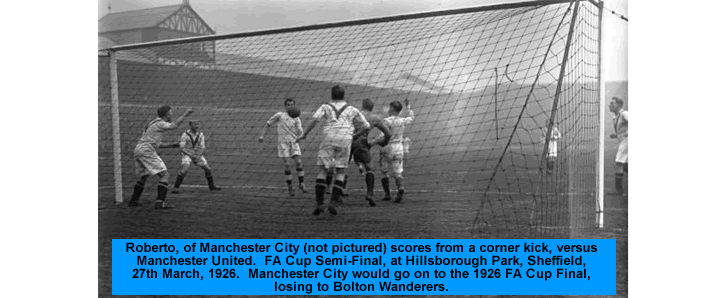
Two years later (1928), Manchester City gained promotion back to the First Division. They finished in 3rd place in 1930, but slipped to 8th place in ’31, and 14th place in ’32. That year Wilfred Wild became manager {see Wilf Wild bio, here}. In 1933, the club had another bad season in the league (16th place), but their cup form was good enough to get them to the FA Cup Final. However, they were defeated handily by a strong Everton side, three goals to nil. The next season (1934) saw a vast improvement in league form, with a 4th place finish. And Manchester City returned to the FA Cup Final (1934), where they faced Portsmouth. The pitch at Wembley was muddy, and parts of the match were played in a thunderstorm. Portsmouth forward Septimus Rutherford scored in the 26th minute, to the consternation of Manchester City’s 19-year old goalkeeper Arthur Swift. At half-time, City’s forward Fred Tilson famously told Swift “you don’t need to worry, I’ll plonk two in next half.” Tilson kept his word, scoring a brace: one in the 73rd minute, and the winner in the 87th minute. At the final whistle, Swift promptly fainted, in relief. {See this article on Manchester City’s 1934 FA Cup victory.}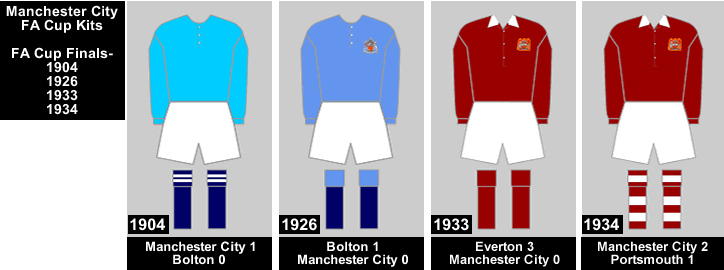
[The four kits above: copyright Historical Football Kits (historicalkits[dot]co[dot]uk), and used by permission.]
Historical Football Kits.co.uk
In 1935, Manchester City finished in 4th place, but slipped to 9th place in 1936. The following season (1936-37), City won only 2 of it’s first 10 matches, and seemed headed for mid-table obscurity again. But Fred Tilson came back from injury, and the squad went on a 22 game unbeaten run, from Boxing Day (Dec. 26.) to the end of the season. In March, Eric Brook (Manchester City’s all-time leading scorer; {see his bio, here}) had a hat-trick, as City beat Liverpool. On 10 April, they beat giants Arsenal (who won 5 league titles in the 1930′s) 2-0. A fortnight later, they clinched the league crown with a 4-1 win over Sheffield Wednesday. So in the spring of 1937, Manchester City FC were Champions of England for the first time. The following season they were relegated.
Manchester City has the unwanted distinction of being the only reigning champions in English football history to be relegated. The 1938 squad is also the only team to have been relegated from the English First Division while leading the league in scoring, or with a positive goal difference (of +3). Manager Wilfred Wild was not sacked, though. The next year (1939), City finished 5th, in the Second Division, on the eve of World War II.
Wild decided to step down when league play was resumed after the War, in August, 1946. That season (1946-47), with former player Sam Cowan as manager, Manchester City won the Second Division, and were promoted. Cowan decided to step down, and retire. The new manager was Jock Thomson, who lasted 3 seasons. He is best remembered for bringing in German goalkeeper Bert Trautman, in 1949. Initially, it was an extremely unpopular move, as Trautman had fought for the Germans in WWII. But the goalie spent 15 seasons at City, and was crucial to the club’s later Cup success. {See this ESPN article about Bert Trautman.} Thomson was sacked when City were relegated, once again, in 1950. . 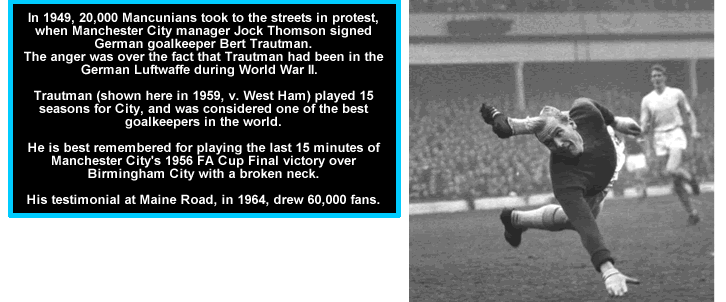
Les McDowell took over as manager that year, and led Manchester City back to the First Division the next season. McDowell had played for City from 1937-48. In 1954, influenced by the innovative Hungarian national team, he started tinkering with Manchester City’s formation. Wing backs were deployed, with a deep-lying central forward playing behind the strikers. The ball would be kept on the ground, and attacks were built up in a slow, deliberate way. This would counteract the stodgy W-M formation, with long booming kicks (ie, “Route 1″ football), that was the absolute norm in the British game. In 1953, at Wembley, the Hungarians had demolished the English national team 6-3. With their fluid formation, the “Mighty Magyars” ran circles around the England squad, passing and setting up attacks at will. The style the Hungarians used was a precursor to the Dutch “total football” of the late ’60′s/early ’70′s. But in the mid 1950′s, few English coaches at the club level were willing to take the leap and employ it.
In July, 1954, McDowell had the Manchester City squad in 2 weeks early, to learn the new system. The new formation became known as “the Revie Plan,” for the deep center-forward, Don Revie. In the 1954-55 season, the plan was met with harsh criticism from the fans at Maine Road. And early on, 3 big losses, giving up 5 or more goals with the with the new formation, didn’t help. But as the season wore on, City began getting results. The team would finish in 7th place, an improvement of 10 places from the season before. And their cup run that season took them all the way to the 1955 FA Cup Final. However, Manchester City lost to Newcastle United, 1-3. 
[The two kits above, copyright Historical Football Kits (historicalkits[dot]co[dot]uk), and used by permission.]
The following season (1955-56), Manchester City improved 3 places, to 4th in the league. And they made it back to the FA Cup Final (1956), facing Birmingham City. Striker Joe Hayes scored for Manchester City in the 3rd minute, from a Don Revie back-heel pass. But Birmingham equalised in the 15th minute, with a goal by Noel Dyson. Manchester City’s methodical passing game began to tire out the Brummie squad, and just after the hour mark, City scored twice in three minutes. In the 65th minute, Jack Dyson scored. In the 68th minute, Dyson fed a pass to Bobby Johnstone, who scored to give City a 2-goal lead. But Trautman had to repel a late Birmingham onslaught. The keeper injured his neck when saving what looked like a sure goal, colliding with Birmingham’s Peter Murphy. In an era of no substitutions, Trautman played on, though in obvious agony. The 3-1 score held up, and Manchester City had won it’s third FA Cup. An X-ray 3 days later revealed that Trautman had broken his neck in the match, and had risked his life remaining on the pitch. 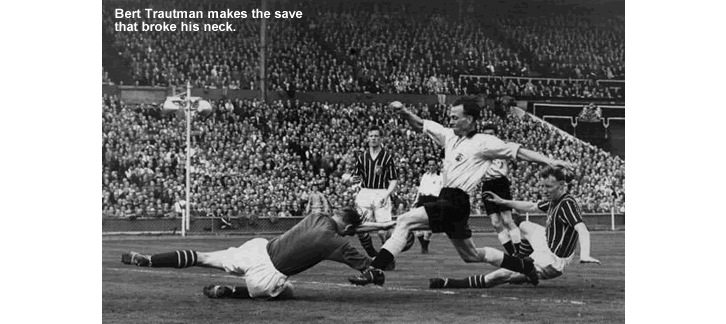 **{Click here, to see newreel footage of Manchester City’s 1956 FA Cup victory.}** {See this article on the match.}
**{Click here, to see newreel footage of Manchester City’s 1956 FA Cup victory.}** {See this article on the match.} 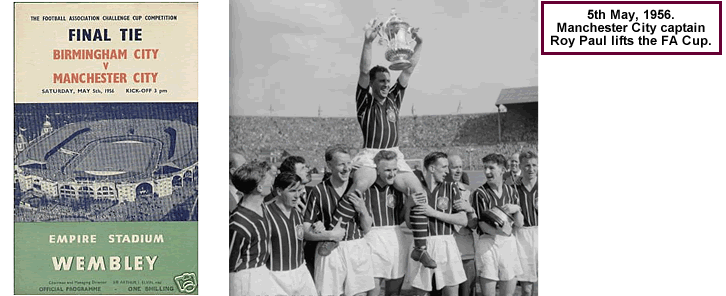
End, Part 1.
Thanks to: (historicalkits[dot]co[dot]uk); Sven A. Hanssen’s excellent Manchester City FC Supporter’s Homepage (uit.no/mancity); (mancityprogrammes[dot]co[dot]uk); Chirk Colliers AFC site (chirkaaafc[dot]com); (viewimages[dot]com); (fa-cupfinals[dot]co[dot]uk); BBC.
